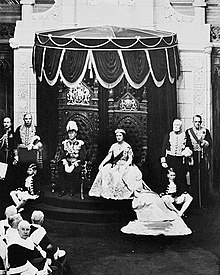御准

加拿大國王喬治六世御准加拿大議院的法律,右為伊麗莎白皇后,1939年5月19日。
御准又稱王室同意(英语:Royal Assent),是指立憲君主正式批准並頒布其國家議會法案,由此建立法律的程序。對絕大多數的現代君主政體而言,御准僅是一項例行程序;但即使在統治者仍有權拒絕授予御准的國家(例如英國、马来西亚、挪威和列支敦斯登),統治者也甚少動用此權,而是遵從其政府的決策,以免陷國家於可怕的政治危機中(參見保留權)。歐洲君主政體對否決權的行使曾實為頻繁;但自18世紀發展出現代民主政治氛圍後,拒授御准的情形已極為少見。
御准通常是以英皇制誥等較為書面的方式進行授予,有時也會伴隨著詳盡儀式。例如在英國,上議院專員在經君主任命後,負責在西敏宮的典禮上宣布批予御准。在其他國家,如澳大利亞和加拿大,僅由總督簽署法案。然而,無論是御准方式為何,議會在事後必須獲知御准;此可以由兩種途徑:上議院專員或君主的代表在各議院在場時公開授予御准;或者個別通知議院,對象通常是該議院議長。
相關程式
在英國,法案行將獲得御准前,必須已經在國會上下兩院通過所有必需的階段(即所謂“三讀流程”)。根據1911年和1949年議會法令,下議院可以在若干情況下,徑直將一項法案呈諸御准,而無需征得上議院的同意。正常地,御准常由君主或經由英皇制誥授權的上議院專員行使。該御准可能於議會內或議會外批出:在後一種情況下,在該法案正式生效前,上下兩院必須分別向君主提出呈請。
在議會中,供職上議院的國會執行秘書(Clerk of the Parliaments),會以傳統盎格魯-諾曼法律法語(Anglo-Norman Law French)的程式性短語,表明君主的決定。通常的流程為:首先大法官在上議院專員陪同下,於上議院宣讀涉及該法案之英皇制誥。然後,駐大法官署皇室執行秘書(Clerk of the Crown in Chancery)讀出該法案的簡稱。接著國會執行秘書面向院內欄柵外側下議院代表(通常為下院正副議長、下院秘書、警衛官及相關法案委員會之議員眾人等)逐一用上述短語回應相關法案的御准詳情。同時這句話也具列在法案之中,以表明君主批給該法案御准。
御准內容
當獲御准之法案為撥款事宜時,常用"La Reyne /Le Roy remercie ses bons sujets, accepte leur benevolence, et ainsi le veult",“女王/國王感謝其優秀之臣民,接受其盛情善意,并依其所願執行之”(英語:"The Queen / The King thanks her good subjects, accepts their bounty, and wills it so.")。
當獲御准之法案為其他公共事宜草案時,常用"La Reyne /Le Roy le veult",“女王/國王依其所願准行之”(英語:"The Queen / The King wills it")。
當獲御准之法案為私人條例草案時,常用"Soit fait comme il est désiré",“因之所需,允其所請” (英語:"let it be as it is desired")。
當相關呈請之議案未獲御准時,通常會以委婉的形式表達: "La Reyne /Le Roy s'avisera",“女王/國王就此再行三思,容后聖裁” ("the Queen /the King will consider it")。
外部連結
1967年御准法案,現今已經修訂且生效。英國成文法數據庫。